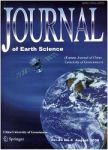Serpentine Jade(Bowenite) in Korea
Serpentine Jade (Bowenite) in Korea出 版 物:《Journal of Earth Science》 (地球科学学刊(英文版))
年 卷 期:2000年第19卷第2期
页 面:11-14页
核心收录:
学科分类:0709[理学-地质学] 070901[理学-矿物学、岩石学、矿床学] 07[理学]
基 金:This paperis supported by the Korea Science and Engineering Foun-dation!( 95 -1-0 5 -0 1-0 1-2 ) the Center for Mineral Res
主 题:bowenite serpentine serpentinite Booyo Korea.
摘 要:A bowenite deposit, recently discovered in Booyo County, Republic of Korea, is the first of its kind in the country. This deposit is located along the contacts of garnet veins intruding the serpentinite. The bowenite is translucent, dark green in color, greasy in luster, 5 in Mohs ’ scale of hardness, ~2.57 in SG , 2.58 in RI , and 1.56 in N D . The X ray powder diffraction analysis identified the bowenite as antigorite of the serpentine group minerals, whose major chemical compositions are composed of SiO 2 (42.49 %), MgO (39.08 %), Fe 2O 3 (3.85 %), and H 2O (11.87 %) and whose important trace elements include Cr (2 188×10 -6 ), Ni (1 110×10 -6 ), and Co (58×10 -6 ). The IR spectrum shows the absorptions at 3 670 (OH stretching), 1 190, 1 070, 980 (SiO stretching) and 610 cm -1 (OH bending). The DTA/TGA thermogram shows the peaks at 343, 755 and 830.1 ℃. The endothermic reaction at 755 ℃ denotes expulsion of structural water, and the strong exothermal reaction at 830.1 ℃ is related to the formation of olivine. Black inclusions finely dispersed in the mineral are identified, with X ray Gandolfi camera method, as magnetite.



